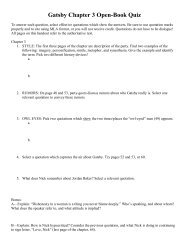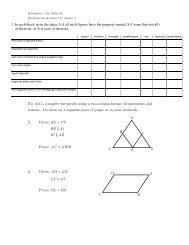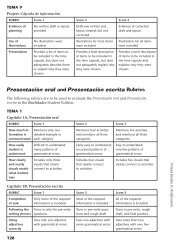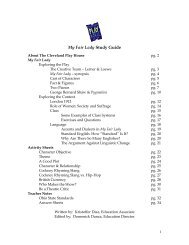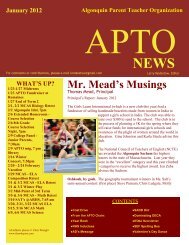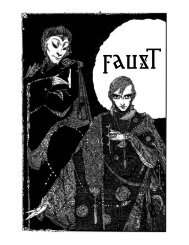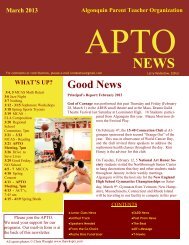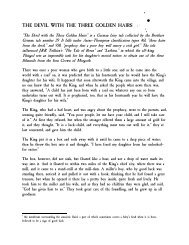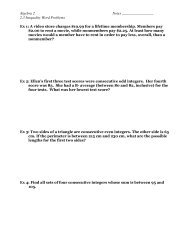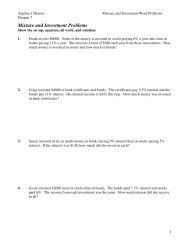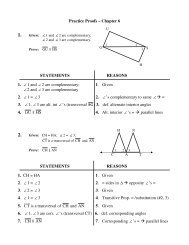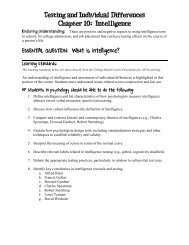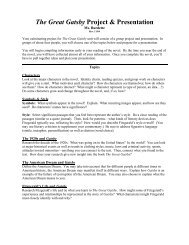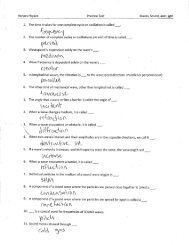Goethe's Use of the Mirror Image
Goethe's Use of the Mirror Image
Goethe's Use of the Mirror Image
You also want an ePaper? Increase the reach of your titles
YUMPU automatically turns print PDFs into web optimized ePapers that Google loves.
<strong>Goe<strong>the</strong>'s</strong> <strong>Use</strong> <strong>of</strong> <strong>the</strong> <strong>Mirror</strong> <strong>Image</strong>Author(s): Rita TerrasSource: Monatshefte, Vol. 67, No. 4 (Winter, 1975), pp. 387-402Published by: University <strong>of</strong> Wisconsin PressStable URL: http://www.jstor.org/stable/30165181Accessed: 04/05/2010 12:21Your use <strong>of</strong> <strong>the</strong> JSTOR archive indicates your acceptance <strong>of</strong> JSTOR's Terms and Conditions <strong>of</strong> <strong>Use</strong>, available athttp://www.jstor.org/page/info/about/policies/terms.jsp. JSTOR's Terms and Conditions <strong>of</strong> <strong>Use</strong> provides, in part, that unlessyou have obtained prior permission, you may not download an entire issue <strong>of</strong> a journal or multiple copies <strong>of</strong> articles, and youmay use content in <strong>the</strong> JSTOR archive only for your personal, non-commercial use.Please contact <strong>the</strong> publisher regarding any fur<strong>the</strong>r use <strong>of</strong> this work. Publisher contact information may be obtained athttp://www.jstor.org/action/showPublisher?publisherCode=uwisc.Each copy <strong>of</strong> any part <strong>of</strong> a JSTOR transmission must contain <strong>the</strong> same copyright notice that appears on <strong>the</strong> screen or printedpage <strong>of</strong> such transmission.JSTOR is a not-for-pr<strong>of</strong>it service that helps scholars, researchers, and students discover, use, and build upon a wide range <strong>of</strong>content in a trusted digital archive. We use information technology and tools to increase productivity and facilitate new forms<strong>of</strong> scholarship. For more information about JSTOR, please contact support@jstor.org.University <strong>of</strong> Wisconsin Press is collaborating with JSTOR to digitize, preserve and extend access toMonatshefte.http://www.jstor.org
GOETHE'S USE OF THE MIRROR IMAGERITA TERRASConnecticut CollegeIn <strong>the</strong> year 1823, upon receiving some news from Sesenheim, Goe<strong>the</strong> wrotea brief essay generally known as "Wiederholte Spiegelungen." In it Goe<strong>the</strong>contends that important events in a person's life will, in that person's mind,undergo a process <strong>of</strong> assimilation and purification which may be compared to<strong>the</strong> natural phenomenon <strong>of</strong> multiple reflections. In <strong>the</strong> same manner as mirrorsare capable <strong>of</strong> reflecting light, a symbolic mirror is able to reflect not only man'sdeeds and thoughts, but also <strong>the</strong> history <strong>of</strong> art, <strong>the</strong> sciences, <strong>the</strong> Church, and<strong>the</strong> political world. Multiple reflections (<strong>the</strong> German word "Spiegelungen" iswithout <strong>the</strong> double meaning present in <strong>the</strong> English word "reflections"), Goe<strong>the</strong>says, do not pale, but ra<strong>the</strong>r enhance and magnify events, making <strong>the</strong> mirror amost powerful instrument. Thus <strong>the</strong> natural, optical phenomenon <strong>of</strong> multiplereflections may serve <strong>the</strong> poet as a useful symbol.'Although Goe<strong>the</strong> did not come to <strong>the</strong>se conclusions until late in his life, <strong>the</strong>mirror image appears constantly in his work, from <strong>the</strong> earliest period in Leipzigup through <strong>the</strong> works <strong>of</strong> his old age, from <strong>the</strong> "Tugendspiegel"(1767) toWilhelm Meisters Wanderjahre (1829) and Faust II. And so <strong>the</strong> image <strong>of</strong> <strong>the</strong>mirror has been suggested to be one <strong>of</strong> <strong>the</strong> more important images in <strong>Goe<strong>the</strong>'s</strong>work. Konrad Burdach and Franz Koch have interpreted Faust as well as<strong>Goe<strong>the</strong>'s</strong> entire artistic endeavor as <strong>the</strong> reflection <strong>of</strong> a creative mirror (einesschaffenden Spiegels).2 More recently, Karl Schlechta devoted a whole chapter<strong>of</strong> his book on <strong>Goe<strong>the</strong>'s</strong> Wilhelm Meister to reflections in a mirror. WilhelmEmrich in Die Symbolik von Faust HII calls <strong>the</strong> phenomenon <strong>of</strong> reflection one <strong>of</strong>four basic conditions (Zustinde) in <strong>Goe<strong>the</strong>'s</strong> poetic work, while L.A. Willoughbyrecognizes <strong>the</strong> mirror as one <strong>of</strong> a small number <strong>of</strong> images which recur throughout<strong>Goe<strong>the</strong>'s</strong> life with remarkable persistence.3 Without wanting to argue <strong>the</strong>validity <strong>of</strong> previous interpretations <strong>of</strong> <strong>the</strong> mirror motif in <strong>Goe<strong>the</strong>'s</strong> work, Ishould like, at this time, to investigate <strong>the</strong> mirror image in a much narrowersense than has been done in previous research. Conceiving <strong>the</strong> image as a vehicleI should like to concern myself with <strong>the</strong> various modes <strong>of</strong> its use.Of course, words such as "Spiegel," "Glas," "Kristall,""sich spiegeln,""wiederspiegeln,""Spiegelung,""Spiegelbild" frequently occur where <strong>the</strong> mirrorimage is used. However, in examining this image one cannot limit one'sconcern to instances <strong>of</strong> <strong>the</strong> specific use <strong>of</strong> <strong>the</strong>se words. While it is true that lyricMonatshefte, John D. Workman Issue, Vol. 67, No. 4, 1975
<strong>Goe<strong>the</strong>'s</strong> <strong>Use</strong> <strong>of</strong> <strong>the</strong> <strong>Mirror</strong> <strong>Image</strong> 389flected by <strong>the</strong> mirror's powers. As seer <strong>of</strong> secrets <strong>the</strong> mirror was believed to beable to predict <strong>the</strong> future, and as such it was <strong>of</strong>ten consulted in matters <strong>of</strong> love,fortune, and death. Mystics <strong>of</strong> all kinds saw <strong>the</strong> soul as a mirror receiving andreflecting God. The image <strong>of</strong> God and man-creator and creation-as mirror andreflection was secularized in <strong>the</strong> eighteenth century and <strong>the</strong> idea developed that<strong>the</strong> soul <strong>of</strong> an artist functions as <strong>the</strong> mirror <strong>of</strong> <strong>the</strong> world.9 It is in this contextthat <strong>the</strong> mirror image attains, perhaps, <strong>the</strong> status <strong>of</strong> a primordial image showing,indeed, many similarities with o<strong>the</strong>r primal images. <strong>Goe<strong>the</strong>'s</strong> use <strong>of</strong> <strong>the</strong> mirrorimage in this context can easily be documented. Yet, <strong>Goe<strong>the</strong>'s</strong> mirror imagerycannot be fully understood in <strong>the</strong>se terms.If we differentiate between <strong>the</strong> mirror as a figurative image and <strong>the</strong> mirroras a structural image or device, we find, first <strong>of</strong> all, that <strong>the</strong> mirror is not usedprimarily as a figurative image in <strong>Goe<strong>the</strong>'s</strong> work. It appears just as <strong>of</strong>ten as astructural image or device with <strong>the</strong> mirrored object forming <strong>the</strong> substance <strong>of</strong> <strong>the</strong>imagery. When used in this latter manner <strong>the</strong> mirror, while a powerful instrument,is merely a catalyst which owes its significance to that which it reflects. Inits structural function <strong>the</strong> mirror image seems to be rooted in conscious intellectualactivity ra<strong>the</strong>r than unconscious animation <strong>of</strong> <strong>the</strong> archetype. The structuralmirror image has little or no connection with tradition; its use is based onscientific insights. As such it is not a psychological, but ra<strong>the</strong>r an aes<strong>the</strong>ticphenomenon.When used by Goe<strong>the</strong> as a figurative image <strong>the</strong> mirror appears ei<strong>the</strong>r as asymbol <strong>of</strong> knowledge or as an image <strong>of</strong> vanity, bringing into focus <strong>the</strong> question<strong>of</strong> woman's virtue. As a figurative image it is <strong>of</strong>ten surrounded by o<strong>the</strong>r imageswhich sharpen <strong>the</strong> intended meaning ei<strong>the</strong>r by concurrence or by polarization.Its use is confined to lyric poetry and to <strong>the</strong> more lyrical passages in o<strong>the</strong>rgenres.When used as a structural image <strong>the</strong> mirror is almost invariably a quietobserver <strong>of</strong> man. While so complex an instrument as to be able to producemultiple, magnified, reversed, true, and distorted reflections, it itself remainscompletely in <strong>the</strong> background. As a matter <strong>of</strong> fact, <strong>the</strong> mirror is <strong>of</strong>ten notmentioned at all. Of importance is only its reflection. In its structural function<strong>the</strong> mirror image is most important as an instrument <strong>of</strong> self-realization, <strong>of</strong>self-identification. As a structural device <strong>the</strong> mirror is invested with <strong>the</strong> power todisclose what cannot be o<strong>the</strong>rwise formulated, and to induce action. Its impactis dramatic, and it occurs with greater frequency in <strong>Goe<strong>the</strong>'s</strong> novels and plays. In1827 Goe<strong>the</strong> described in a letter to K.J.L. Iken what is essentially <strong>the</strong> structural-ra<strong>the</strong>rthan <strong>the</strong> figurative-use <strong>of</strong> <strong>the</strong> mirror image: "Da sich manchesunserer Erfahrung nicht rund aussprechen und direkt mitteilen lat|t, so habe ichseit langem das Mittel gewahlt, durch einander gegentibergestellte und sichgleichsam ineinander abspiegelnde Gebilde den geheimen Sinn dem Aufmerkendenzu <strong>of</strong>fenbaren."10 In this explanation Goe<strong>the</strong> does not even mention<strong>the</strong> mirror itself. What is important to him are reflections and cross-reflections
390 Terrascreated by invisible mirrors. In <strong>the</strong> same way, <strong>the</strong> emphasis in his essay "WiederholteSpiegelungen" lies with <strong>the</strong> reflections <strong>of</strong> <strong>the</strong> mirror, not with <strong>the</strong> mirroritself. Reflected and cross-reflected forms, as Goe<strong>the</strong> calls <strong>the</strong>m, manifest <strong>the</strong>mselvesin a variety <strong>of</strong> manners in his work. Frequently a poetic character seeshimself reflected in a fictitious character created by ano<strong>the</strong>r author. He may alsohear about a fate similar to his own, or a real or imagined substitution <strong>of</strong> onecharacter by ano<strong>the</strong>r may occur. Finally, a real Doppelganger may appearopposite <strong>the</strong> poetic character.In Die Laune des Verliebten (1768) <strong>the</strong> mirror image is used as a stylisticdevice when Egle scolds Amine for reading love novels and taking <strong>the</strong>m asexamples for her behavior towards Eridon, who constantly bo<strong>the</strong>rs her with hisjealousy.Ein seufzender Roman zu dieser Zeit gelesen,Verdreht uns gar den Kopf; wir glauben uns zu finden,Wir wollen elend sein, wir wollen iiberwinden.Ein junges Herz nimmt leicht den Eindruck vom Roman,Allein, ein Herz, das liebt, nimmt ihn noch leichter an (IV, 15).The same motif, but considerably more elaborate, appears in Die Geschwisterand also in Wer<strong>the</strong>r. Marianne in Die Geschwister tells her bro<strong>the</strong>r:Ich weilm wohl noch, daif du manchmal lachtest, wenn ich Romane las: esgeschah einmal mit der Julie Mandeville, und ich fragte, ob der Heinrich,oder wie er heiimt, nicht ausgesehen habe wie du.-Du lachtest-das gefiel mirnicht .... Mir war's aber ganz ernsthaft: denn was die liebsten, die bestenMenschen waren, die sahen bei mir wohl alle aus wie du. Dich sah ich in demgrollen Garten spazieren, und reiten, und reisen, und sich duellieren. Dai3 ichebenso auch gestehe: wenn eine Dame recht hiibsch war und recht gut-undrecht verliebt-das war ich immer selbst.-... Unter allem konnte ich amwenigsten leiden, wenn sich ein paar Leute liebhaben und endlich komm<strong>the</strong>raus, dafi sie verwandt sind oder Geschwister sind (IV, 367).Here <strong>the</strong> intriguing aspect <strong>of</strong> <strong>the</strong> mirror image lies in <strong>the</strong> fact that <strong>the</strong> reader isdefinitely aware <strong>of</strong> matters as <strong>the</strong>y really stand. Marianne, meanwhile, seems torelate her phantasies in complete naivete, assuming that she speaks to her olderbro<strong>the</strong>r, and without realizing that she loves him with all her heart, as one lovesa husband. At <strong>the</strong> same time, <strong>the</strong> fact that she sees her bro<strong>the</strong>r riding, duelling,in short taking part in activities which he, being what he is, could hardly beexpected to engage in, means that <strong>the</strong> reflection <strong>of</strong> her bro<strong>the</strong>r in <strong>the</strong> mirror <strong>of</strong><strong>the</strong> novel allows Marianne to realize a potential in her bro<strong>the</strong>r that wouldo<strong>the</strong>rwise remain hidden. Observe how <strong>the</strong> novels, disliked by Marianne, presentan exactly reversed picture <strong>of</strong> her own situation. In <strong>the</strong> novels people fall in loveonly to discover that <strong>the</strong>y are related; Marianne assumes that she lives with herbro<strong>the</strong>r only to discover that he is not her bro<strong>the</strong>r. <strong>Goe<strong>the</strong>'s</strong> use <strong>of</strong> <strong>the</strong> mirrorimage here stays very close to <strong>the</strong> optical fact <strong>of</strong> reverse reflection.
<strong>Goe<strong>the</strong>'s</strong> <strong>Use</strong> <strong>of</strong> <strong>the</strong> <strong>Mirror</strong> <strong>Image</strong> 391In Wer<strong>the</strong>r (letter, June 16) Lotte remarks that she loved nothing betterthan to read and to take part in <strong>the</strong> fate <strong>of</strong> fictitious Miss Jenny, <strong>the</strong> character <strong>of</strong>a novel. "Der Autor ist mir der liebste, in dem ich meine Welt wiederfinde, beidem es zugeht wie um mich," she continues and mentions Goldsmith's The Vicar<strong>of</strong> Wakefield as one <strong>of</strong> her favorites (VI, 23). Wer<strong>the</strong>r (letter, November 26)writes to Wilhelm: "Manchmal sage ich mir: Dein Schicksal ist einzig; preise dieuibrigen ghicklich-so ist noch keiner gequilt worden. Dann lese ich einen Dichterder Vorzeit, und es ist mir, als saihe ich mein eigenes Herz" (VI, 88). Lotte andWer<strong>the</strong>r are fully aware <strong>of</strong> <strong>the</strong> similarity <strong>of</strong> <strong>the</strong>ir own fate with that <strong>of</strong> <strong>the</strong>irliterary reflections. They recognize <strong>the</strong>mselves in <strong>the</strong> reflection, and this assures<strong>the</strong>m <strong>of</strong> being part <strong>of</strong> some grandiose plan governing <strong>the</strong> universe instead <strong>of</strong> anindividual singled out and all alone. The effect <strong>of</strong> <strong>the</strong> use <strong>of</strong> <strong>the</strong> mirror is that <strong>of</strong>presenting a true and concentrated reflection.Even more substantial and impressive than <strong>the</strong> use <strong>of</strong> literary reflections is<strong>the</strong> mirror image when used as a truly narrative-structural device, specifically incases when <strong>the</strong> plot <strong>of</strong> a story is advanced through knowledge, most <strong>of</strong>tenself-realization, gained by <strong>the</strong> story's characters through <strong>the</strong> observance <strong>of</strong> areflection <strong>of</strong> o<strong>the</strong>rs, or <strong>of</strong> <strong>the</strong>mselves. Some <strong>of</strong> <strong>the</strong> most striking instances <strong>of</strong>such mirror imagery are to be found in Wilhelm Meister, this time with a realmirror present. In <strong>the</strong> Lehrjahre (1794-96; book III, chapter 10) Wilhelm ispersuaded to impersonate <strong>the</strong> absent Count by wearing his clo<strong>the</strong>s and sitting inhis chair in his library. Looking up, Wilhelm suddenly sees <strong>the</strong> real Count'sreflection in a mirror. The Count unexpectedly arrived home early and uponentering his library finds himself confronted with his Doppelganger reflected in<strong>the</strong> mirror. He does not realize that <strong>the</strong> reflection is that <strong>of</strong> Wilhelm impersonatinghim and, since seeing one's double traditionally means bad luck or evendeath, <strong>the</strong> encounter leaves <strong>the</strong> impetuous man in a quiet and reflective mood, achanged person (VII, 190f.). But it is not only <strong>the</strong> Count who is shaken intoself-contemplation by <strong>the</strong>ir confrontation. Wilhelm, too, feels subdued by <strong>the</strong>unexpected return <strong>of</strong> <strong>the</strong> Count whose figure he sees reflected in <strong>the</strong> mirror. Theanticipated adventure <strong>of</strong> meeting <strong>the</strong> Countess could have easily turned into atragedy. Goe<strong>the</strong>, through <strong>the</strong> medium <strong>of</strong> cross-reflections, brings into focus andexplains in a flash <strong>the</strong> complicated psychological processes taking place inWilhelm and in <strong>the</strong> Count. In Wilhelm <strong>the</strong> ill-fated prank changes slight feelings<strong>of</strong> uneasiness into guilt. It produces self-reflection and self-evaluation in <strong>the</strong>Count, leading to catharsis in both characters.In <strong>the</strong> Wanderjahre, <strong>the</strong> novella "Wer ist der Verriter? " stands out for <strong>the</strong>structural use <strong>of</strong> <strong>the</strong> mirror image. Reflection in a mirror is central to <strong>the</strong>development <strong>of</strong> its plot. Lucidor, <strong>the</strong> protagonist, believes that his belovedLucinde belongs to ano<strong>the</strong>r when he observes her and a friend in a mirror. He isin despair. Later, when embracing his girl for <strong>the</strong> first time he coincidentallyfinds himself in front <strong>of</strong> <strong>the</strong> same mirror and gratefully recognizes <strong>the</strong> truth andhis own good fortune (VII, 85-104). Goe<strong>the</strong> uses <strong>the</strong> mirror as an instrument<strong>of</strong> deception as well as <strong>of</strong> revelation. Lucidor perceives <strong>the</strong> mirrored reflection <strong>of</strong>
392 Terrashis beloved and ano<strong>the</strong>r man not as a true but as a distorted image, which iscorrected only when he sees his own and Lucinde's reflection. The mirrorreflections create and solve <strong>the</strong> complexities <strong>of</strong> <strong>the</strong> plot <strong>of</strong> this novella. Thenovella itself is constructed as a parallel to <strong>the</strong> main story <strong>of</strong> Wilhelm Meister. Itrelates to <strong>the</strong> novel as a mirror reflection to <strong>the</strong> original, particularly as far as <strong>the</strong>main character is concerned. Lucidor is a second Wilhelm. He is at first completelyhelpless. Gentle guidance finally brings him to recognize his happiness.11Significantly, <strong>the</strong> "Spiegelglasszene" <strong>of</strong> <strong>the</strong> Lehrjahre is missing in WilhelmMeisters <strong>the</strong>atralische Sendung (begun in 1777), although <strong>the</strong> surrounding scenesare <strong>the</strong> same in both versions <strong>of</strong> <strong>the</strong> novel. This, apart from <strong>the</strong> more skillful use<strong>of</strong> <strong>the</strong> mirror image in <strong>Goe<strong>the</strong>'s</strong> later work, suggests that <strong>the</strong> poet became moreand more aware <strong>of</strong> <strong>the</strong> importance <strong>of</strong> this image and used it more consciouslyand in accord with his <strong>the</strong>ories <strong>of</strong> symbolic expression.The same can be shown also for <strong>Goe<strong>the</strong>'s</strong> use <strong>of</strong> <strong>the</strong> Doppelgianger motif inWer<strong>the</strong>r. In <strong>the</strong> 1774 version <strong>of</strong> <strong>the</strong> novel <strong>the</strong> protagonist has only one double,<strong>the</strong> clerk who loved Lotte and lost his mind when forced to leave her. Missing inthis version is <strong>the</strong> farmhand episode, in which <strong>the</strong> rejected lover kills hisopponent in a jealous rage. Without <strong>the</strong> figure <strong>of</strong> <strong>the</strong> farmhand <strong>the</strong> use <strong>of</strong> <strong>the</strong>Doppelgainger motif in Wer<strong>the</strong>r remains unclear and remote. Equally as unimpressiveas <strong>the</strong> use <strong>of</strong> <strong>the</strong> Doppelgianger image in <strong>the</strong> 1774 version <strong>of</strong> Wer<strong>the</strong>r isits use in Urfaust, unchanged in Faust I. Looking at it from a structural point <strong>of</strong>view it may easily be missed completely. Gretchen's double, Birbelchen, doesnot even appear in <strong>the</strong> play. We simply learn about her through <strong>the</strong> words <strong>of</strong>Gretchen's friend, Lieschen.An interesting difference between <strong>the</strong> Doppelgainger motif in <strong>the</strong> earlyworks as opposed to <strong>the</strong> Wanderjahre, where Lucidor could be called Wilhelm'sdouble, may be found in <strong>the</strong> time dimension. The structural mirror image in <strong>the</strong>earlier works is used to foreshadow disaster, as we have observed in <strong>the</strong>Lehrjahre and as we will see in Wer<strong>the</strong>r and in Faust L In <strong>the</strong> later works-this istrue for Die Wahlverwandtschaften (1809) as well-its function seems to becloser to that <strong>of</strong> a chorus in Greek tragedy. Its role is that <strong>of</strong> a commentator onthings past and present, but not on <strong>the</strong> future. In Wer<strong>the</strong>r, Faust I, andLehrjahre <strong>the</strong> double is a symbol <strong>of</strong> warning. The audience, well aware <strong>of</strong> <strong>the</strong>protagonist's fate, immediately recognizes <strong>the</strong> double as a harbinger <strong>of</strong> misfortune.Not so <strong>the</strong> protagonist himself who, up to this point, has been unaware <strong>of</strong><strong>the</strong> seriousness <strong>of</strong> <strong>the</strong> situation. Yet, intuitively and subconsciously he, too,comes to realize his own fate in that <strong>of</strong> <strong>the</strong> Doppelgainger, as he is beset bydoubts, by guilt, or by sorhe o<strong>the</strong>r kind <strong>of</strong> uneasiness. Eventually <strong>the</strong> reflectiontakes hold and <strong>the</strong> protagonist recognizes himself in it. Such is <strong>the</strong> case with <strong>the</strong>Count in Lehrfahre, with Gretchen, and with Wer<strong>the</strong>r.In <strong>the</strong> scene "Am Brunnen" Gretchen learns from her friend Lieschen thatano<strong>the</strong>r friend, named Barbelchen, has become pregnant without being married.On <strong>the</strong> way home from <strong>the</strong> well Gretchen suddenly recognizes herself in
<strong>Goe<strong>the</strong>'s</strong> <strong>Use</strong> <strong>of</strong> <strong>the</strong> <strong>Mirror</strong> <strong>Image</strong> 393Birbelchen and becomes aware <strong>of</strong> <strong>the</strong> warning. She is now unable to pass <strong>of</strong>fLieschen's story as a mere piece <strong>of</strong> gossip. She says:Wie konnt' ich sonst so tapfer schmlilen,Wenn tiit ein armes M~igdlein fehlen!Wie konnt' ich iUber andrer StindenNicht Worte gnug der Zunge finden! (3577-80).Similarly Wer<strong>the</strong>r when he writes: "Wilhelm, der Mensch, von dem ich dirschrieb, der glickliche Ungliickliche, war Schreiber bei Lottens Vater und eineLeidenschaft zu ihr... hat ihn rasend gemacht. Fiihle, bei diesen trockenenWorten mit welchem Unsinne mich die Geschichte ergriffen hat, da mir sieAlbert ebenso gelassen erzlihlte, als du sie vielleicht liesest" (VI, 91). Note thatAlbert told <strong>the</strong> story without being moved by it, and that Wilhelm presumablyreceives it equally unperturbed. Gretchen's friend, Lieschen, too, remains unaffectedby Birbelchen's fate. Albert and Lieschen are merely <strong>the</strong> glass reflecting<strong>the</strong> image <strong>of</strong> <strong>the</strong> clerk and <strong>of</strong> Birbelchen in which Wer<strong>the</strong>r and Gretchenrecognize <strong>the</strong>mselves. The scientific fact that a mirror reflects what it "sees,"that <strong>the</strong> reflection depends upon <strong>the</strong> input and its perceptibility to <strong>the</strong> onlooker,is applicable here. Wer<strong>the</strong>r and Gretchen are mirrored because <strong>the</strong>ir own fate is,so to speak, on <strong>the</strong> line. For <strong>the</strong>m <strong>the</strong> mirror clarifies and brings into focus whatwas vague before.In <strong>the</strong> later version <strong>of</strong> Wer<strong>the</strong>r (1787) <strong>the</strong>re exists <strong>the</strong> unusual feature <strong>of</strong>two Doppelganger, i.e., a choice <strong>of</strong> possibilities. First, Wer<strong>the</strong>r meets <strong>the</strong> farmhandwho was dismissed by his employer, a "Biuerin," because he is passionatelyin love with her and finds himself unable to stay within <strong>the</strong> bounds <strong>of</strong>propriety. Later he kills his successor in love out <strong>of</strong> jealousy. Secondly, <strong>the</strong>re is<strong>the</strong> former clerk <strong>of</strong> <strong>the</strong> "Amtmann" who was relieved <strong>of</strong> his duties because <strong>of</strong>his love for Lotte, fell victim to madness, and finally is happy in his own littleworld <strong>of</strong> total unawareness. Both <strong>of</strong> <strong>the</strong> doubles foreshadow Wer<strong>the</strong>r's doom.The complexity <strong>of</strong> <strong>the</strong> situation is established with <strong>the</strong> second meeting betweenWer<strong>the</strong>r and <strong>the</strong> farmhand. Now <strong>the</strong> Doppelganger's misfortune definitely fore-casts what Wer<strong>the</strong>r fears. He recognizes his "Schicksalsbruder in dem Knecht,"and finishes his letter to Wilhelm (September 4) with <strong>the</strong> words: "Lies, meinGeliebter, und denke dabei, dais es auch die Geschichte deines Freundes ist. Ja,so ist mirs gegangen, so wird mirs gehen, und ich bin nicht halb so bray, nichthalb so entschlossen, als der arme Ungliickliche, mit dem ich mich zu vergleichenmich fast nicht getraue" (VI, 79). After <strong>the</strong> meeting nothing is decided. ThenWer<strong>the</strong>r meets <strong>the</strong> mad clerk and a new avenue opens up for him. In his letter,dated November 30, we read: "Wo ich hintrete, begegnet mir eine Erscheinung,die mich aus aller Fassung bringt. Heute! o Schicksal! o Menschheit! . . . Gott imHimmel, hast du das zum Schicksale der Menschen gemacht, dail sie nichtglicklich sind, als ehe sie zu ihrem Verstande kommen, und wenn sie ihn wiederverlieren!-" (VI, 88). Again <strong>the</strong> apparition disappears and Wer<strong>the</strong>r's fate still is
394 Terrasnot decided. Later we learn from <strong>the</strong> editor that Wer<strong>the</strong>r was present when <strong>the</strong>farmhand was arrested after murdering his adversary. Wer<strong>the</strong>r makes everyeffort to save him, but his own sympathy for <strong>the</strong> unfortunate young man is notshared by anyone else. He fails. Among Wer<strong>the</strong>r's things <strong>the</strong> editor finds a notesaying: "Du bist nicht zu retten, Ungliicklicher! Ich sehe wohl, daB wir nicht zuretten sind" (VI, 97). Wer<strong>the</strong>r thus will share <strong>the</strong> fate <strong>of</strong> <strong>the</strong> farmhand-Doppelganger, not that <strong>of</strong> <strong>the</strong> madman-Doppelganger. He will not return to <strong>the</strong>paradisaical state <strong>of</strong> mental oblivion. He will instead exercise his own free will,not by killing Albert, to be sure, but ra<strong>the</strong>r by removing himself from a lifewhich has become senseless. The introduction <strong>of</strong> Wer<strong>the</strong>r'second double in <strong>the</strong>later version <strong>of</strong> <strong>the</strong> novel seems to be a structural device which presentsWer<strong>the</strong>r's alternatives more clearly. His choices, mental illness or murder, illustrate<strong>the</strong> hopelessness <strong>of</strong> his situation. Suicide is <strong>the</strong> only o<strong>the</strong>r way out.We have to return to Die Laune des Verliebten in order to mention yetano<strong>the</strong>r utilization <strong>of</strong> <strong>the</strong> Doppelganger image, i.e., that <strong>of</strong> substituting oneperson for ano<strong>the</strong>r to achieve certain ends. This particular use <strong>of</strong> <strong>the</strong> mirrorimage is, <strong>of</strong> course, nothing but ano<strong>the</strong>r version <strong>of</strong> <strong>the</strong> age-old device firstmentioned in <strong>the</strong> Amphitryon legend. In Die Laune des Verliebten <strong>the</strong> doubleappears in a situation which Goe<strong>the</strong> explores to its fullest extent in <strong>the</strong> novel DieWahlverwandtschaften. A substitution occurs. Egle assumes Amine's identity.Eridon embraces and kisses Egle instead <strong>of</strong> his shepherdess Amine who, with <strong>the</strong>help <strong>of</strong> this little ploy, tries to cure Eridon <strong>of</strong> his raging jealousy (IV, 25). Thesubstitution serves a ra<strong>the</strong>r obvious moral intention. It lacks <strong>the</strong> sophistication<strong>of</strong> <strong>the</strong> same image in Wahlverwandtschaften where Eduard is partner to Charlotte'slove-making when she imagines that <strong>the</strong> Hauptmann is present, whileEduard phantasizes that it is Ottilie and not Charlotte who is his partner in love.As it reaches Eduard's soul Charlotte's image is distorted, or enhanced, to <strong>the</strong>point <strong>of</strong> becoming Ottilie. Charlotte's inner mirror perceives Eduard and reflectshis image as that <strong>of</strong> <strong>the</strong> Hauptmann. Both Charlotte and Eduard are fullyconscious <strong>of</strong> <strong>the</strong> reflective powers <strong>of</strong> <strong>the</strong>ir imagination. They play what <strong>the</strong>yknow to be a dangerous game. Eduard leaves Charlotte's room as if it had been<strong>the</strong> scene <strong>of</strong> a crime. The couple shows embarrassment and regret when meetingwith <strong>the</strong> Hauptmann and Ottilie <strong>the</strong> next morning. What begins as a symbolicgame changes into a realized metaphor, as Goe<strong>the</strong> explains: "In der Lampendimmerung...behauptete die Einbildungskraft ihre Rechte uiber das Wirkliche.Eduard hielt nun Ottilie in seinen Armen, Charlotte schwebte der Hauptmannniiher oder ferner vor der Seele" (VI, 321f.). When a son is born to Charlotte andEduard nine months later he bears a striking resemblance not to his parents, butto Ottilie and <strong>the</strong> Hauptmann (VI, 421): <strong>the</strong> mirror has taken on magical powers.Illusion and reality become intertwined. The mirror <strong>of</strong> imagination seems to beable not only to present a reflection, but also to summon creative powersresulting in <strong>the</strong> birth <strong>of</strong> a being with <strong>the</strong> features <strong>of</strong> <strong>the</strong> mirrored reflections.The expression Doppelganger, or ra<strong>the</strong>r Doppeltganger, was coined by JeanPaul.12 For Goe<strong>the</strong> <strong>the</strong>re existed only <strong>the</strong> concept <strong>of</strong> Ebenbild, even though he
<strong>Goe<strong>the</strong>'s</strong> <strong>Use</strong> <strong>of</strong> <strong>the</strong> <strong>Mirror</strong> <strong>Image</strong> 395reports in Dichtung und Wahrheithat once, coming from Sesenheim, he met hisown reflection, dressed in grey and gold and riding in <strong>the</strong> opposite direction. Hecalls his double "das wunderliche Trugbild" (IX, 500). In o<strong>the</strong>r instances he uses<strong>the</strong> designation Ebenbild. Wilhelm in Die Geschwister sees in Marianne "dasEbenbild" <strong>of</strong> her dead mo<strong>the</strong>r whom he loved (IV, 364). Faust fancied himselfas <strong>the</strong> biblical "Ebenbild der Got<strong>the</strong>it" when rebuked by <strong>the</strong> Erdgeist (lines 516and 614). Ebenbild and Doppelganger are closely related concepts. The former isan older, less specific form <strong>of</strong> <strong>the</strong> latter. <strong>Goe<strong>the</strong>'s</strong> realization <strong>of</strong> <strong>the</strong> concept notonly lacks <strong>the</strong> designation Doppelganger, but also shows a basic difference from<strong>the</strong> later, more common forms <strong>of</strong> <strong>the</strong> image in <strong>the</strong> works <strong>of</strong> Romantic andpost-Romantic writers. As Ralph Tymms points out in his study Doubles inLiterary Psychology, "an essential distinction is to be made between <strong>the</strong> doubleby-duplicationand <strong>the</strong> double-by-division.''"13 Only <strong>the</strong> double-by-duplicationfits <strong>the</strong> mirror image. The double-by-division, <strong>the</strong> split personality, such as Faustand Mephistopheles or Tasso and Antonio, does not present a reflection, butra<strong>the</strong>r <strong>the</strong> supplementation <strong>of</strong> one person by ano<strong>the</strong>r. Finally, <strong>Goe<strong>the</strong>'s</strong> mirrorreflections are not imprisoned in any subjective individuality encounteringprojections <strong>of</strong> its own self. They are not mentally imbalanced. His doubles aresymbolic structures presenting rational choices open to his characters. Goe<strong>the</strong>uses <strong>the</strong>m to enlighten <strong>the</strong> audience and, perhaps, even himself.Before moving on to <strong>the</strong> figurative mirror image I wish to mention a moreconventional, less striking but never<strong>the</strong>less common use <strong>of</strong> <strong>the</strong> structural mirrorimage. Throughout <strong>Goe<strong>the</strong>'s</strong> writings, but predominantly in his early works, <strong>the</strong>eye or <strong>the</strong> glance (der Blick) and, slightly less frequently, o<strong>the</strong>r facial expressionsappear as a reflector <strong>of</strong> human emotions. Love, jealousy, rage, sweetness <strong>of</strong> <strong>the</strong>soul, sadness, fright, or a guilty conscience are all shown reflected in <strong>the</strong> eye, on<strong>the</strong> forehead, or in <strong>the</strong> face <strong>of</strong> <strong>Goe<strong>the</strong>'s</strong> poetic characters. The eye, <strong>the</strong> forehead,<strong>the</strong> face have to be taken as extensions <strong>of</strong> <strong>the</strong> soul, and <strong>the</strong> soul has a longtradition as <strong>the</strong> mirror <strong>of</strong> human emotions. Very early, in 1769, and still deep in<strong>Goe<strong>the</strong>'s</strong> anacreontic period, we find <strong>the</strong>se lines in <strong>the</strong> idyllic narration "Kunstdie Sproden zu fangen":Wenn ich sie sah, und sie nicht kiitte,Sprach gleich ihr Blick, dais sie etwas vermiite.14In Faust I we find <strong>the</strong> lines:O schaudre nicht! LaB diesen Blick,Lal diesen Hiindedruck dir sagen,Was unaussprechlich ist (3188-90).The same metaphor appears again and again. What is interesting to observe ishow this particular metaphor gains in substance. Taken from <strong>the</strong> metaphoricarsenal <strong>of</strong> anacreontic poetry, where <strong>the</strong> eye reflects nothing but <strong>the</strong> gamut <strong>of</strong>love, it begins to convey a more varied and more serious meaning as soon as<strong>Goe<strong>the</strong>'s</strong> writing gains in substance and in seriousness. In Die Geschwister love,
396 Terrasnot yet fully recognized but never<strong>the</strong>less irrepressible, is clearly perceived byMarianne in Wilhelm's eyes. The perception is mutual, for Marianne says notonly: "Es tut ihm doch wohl, wenn er mich ansieht," but also, "ich sehs ihm anden Augen ab" (IV, 359). Their eyes reveal what cannot yet be expressed inwords. The physical phenomenon <strong>of</strong> repeated reflections is obvious here. Wilhelm'seyes reflect what he sees on Marianne's face. She perceives what his eyesreflect. Cross-reflection takes place. In Faust I <strong>the</strong> mirror image is even morestrongly charged with substance. All <strong>the</strong> uneasiness which Gretchen feels towardMephistopheles is expressed in <strong>the</strong> two lines:Es steht ihm an der Stirn geschrieben,Dail er nicht mag eine Seele lieben (3489-90).Even a Mephistopheles cannot hide <strong>the</strong> darker side <strong>of</strong> his soul behind a face notreally his own. The most extended use <strong>of</strong> <strong>the</strong> face as a mirror is made in Clavigo,where <strong>Goe<strong>the</strong>'s</strong> stage notes prescribe every expression shown on Clavigo's facewhile Beaumarchaislowly reveals his identity and <strong>the</strong> purpose <strong>of</strong> his visit withClavigo. The mirror does not only show a descriptive painting limited in itstemporal aspects, but reflects a whole sequence <strong>of</strong> action, thus becoming a vitalpart <strong>of</strong> <strong>the</strong> dramatic impact <strong>of</strong> <strong>the</strong> whole scene (IV, 270-272). The eye or <strong>the</strong>face as a mirror <strong>of</strong> human emotions has now extended from merely expressingplayful love to revealing <strong>the</strong> sweetness <strong>of</strong> <strong>the</strong> soul, vice, a guilty conscience.Finally, I will present some examples <strong>of</strong> <strong>the</strong> use <strong>of</strong> <strong>the</strong> mirror as a figurativeimage, symbolizing vanity or utilized as a symbol <strong>of</strong> knowledge. AlthoughGoe<strong>the</strong> uses <strong>the</strong> figurative mirror image symbolizing vanity ra<strong>the</strong>r infrequently,and not at all in his later works, he resorts to it in characterizing a major figuresuch as Gretchen. An early example is found in <strong>the</strong> poem "Kleine Blumen,kleine Bliitter" (1771; new version 1789).Und dann tritt sie fiir den SpiegelMit zufriedner MunterkeitSieht mit Rosen sich umgeben,Sie wie eine Rose jung (I, 26).In this poem <strong>the</strong> mirror appears toge<strong>the</strong>r with various rococo paraphernalia suchas ribbon, Zephyr, and rose. They streng<strong>the</strong>n <strong>the</strong> image <strong>of</strong> playful vanityinitiated by <strong>the</strong> mirror. Later, Goe<strong>the</strong> dispenses with <strong>the</strong> anacreontic metaphors,but he retains <strong>the</strong> mirror as a symbol <strong>of</strong> vanity and continues to surround it witho<strong>the</strong>r images. As such it brings into focus <strong>the</strong> question <strong>of</strong> Gretchen's virtue intwo scenes <strong>of</strong> Faust I: "Abend" and "Der Nachbarin Haus." The mirror is usedto characterize Gretchen as she steps in front <strong>of</strong> it after finding <strong>the</strong> jewelry boxleft by Mephistopheles. Adorning herself she says:Wenn nur die Ohrring meine wiren!Man sieht doch gleich ganz anders drein.Was hilft euch Schinheit, junges Blut?
<strong>Goe<strong>the</strong>'s</strong> <strong>Use</strong> <strong>of</strong> <strong>the</strong> <strong>Mirror</strong> <strong>Image</strong> 397Das ist wohl alles sch6n und gut,Allein man lists auch alles sein,Man lobt euch halb mit Erbarmen.Am Gold hiingtDoch Alles. Ach wir Armen! (2796-2804).Gretchen's vanity borders on immorality in "Der Nachbarin Haus," where shefollows Mar<strong>the</strong>'s devilish suggestion to wear her new jewelry in front <strong>of</strong> <strong>the</strong>mirror even though her mo<strong>the</strong>r and <strong>the</strong> priest had taken Mephistopheles' firstgift from her.Margarete: Darf mich leider nicht auf den GassenNoch in der Kirche mit sehen lassen.Mar<strong>the</strong>: Komm du nur <strong>of</strong>t zu mir heriiberUnd leg den Schmuck hier heimlich anSpazier ein Stiindchen lang dem Spiegelglas voriiberWir haben unsre Freude dran (2883-87).In a strictly moralistic interpretation Gretchen's virtue is questionable. Vanityra<strong>the</strong>r than obedience determine her behavior, possibly foreshadowing tragedyby revealing her human frailty. The contrast created by <strong>the</strong> use <strong>of</strong> imagery in<strong>the</strong>se two scenes is remarkable. In "Abend" <strong>the</strong> mirror is silently present as <strong>the</strong>devil's insensitive and undiscerning accomplice. Its icy texture is expressed by<strong>the</strong> use <strong>of</strong> <strong>the</strong> word "Spiegelglas" in "Der Nachbarin Haus." In stark contrast to<strong>the</strong> coldness <strong>of</strong> <strong>the</strong> mirror in both <strong>of</strong> <strong>the</strong>se scenes <strong>the</strong>re appear <strong>the</strong> words "jungesBlut," "Erbarmen," and "wir Armen," all <strong>of</strong> which suggest warmth and pulsatinglife. The same can be said <strong>of</strong> <strong>Goe<strong>the</strong>'s</strong> choice <strong>of</strong> <strong>the</strong> diminutive "Stindchen."<strong>Goe<strong>the</strong>'s</strong> predilection for contrasting images has been sufficiently documented.1sThe figurative image <strong>of</strong> <strong>the</strong> cold mirror polarized with warmth andplenitude must be added to <strong>the</strong> existing list. We find ano<strong>the</strong>r example <strong>of</strong> thispolarization <strong>of</strong> imagery in an early poem, Triumph der Tugend. Zwote Erzdhlung(1767), which shows deeper perception than o<strong>the</strong>r poems <strong>of</strong> <strong>the</strong> sameperiod and also has more substance which is present in <strong>the</strong> mirror image as well.In this poem <strong>the</strong> mirror appears both as a figurative image and as a structuraldevice. The mirror becomes central to <strong>the</strong> development <strong>of</strong> <strong>the</strong> ra<strong>the</strong>r dramaticpoem. A young man observes his girl friend sans clo<strong>the</strong>s in front <strong>of</strong> a mirrorwithout her being aware <strong>of</strong> his presence. Her full beauty is revealed, enhanced by<strong>the</strong> falling hair which is compared to <strong>the</strong> branches <strong>of</strong> a rose bush.Was sie mir nie zu sehn verg6nnte,Des Busens volle Bliite wiesSie dem verschwiegnen kalten Spiegel, lietDas Haar geteilt von ihrem Scheitel fallen,Wie Rosenzweig um Knospen, um den Busen wallen.16As in <strong>the</strong> Faust I scenes, <strong>the</strong> attributes <strong>of</strong> <strong>the</strong> mirror ("verschwiegen" and"kalt") label it as dispassionate, dead matter and place it in stark contrast to <strong>the</strong>
398 Terraswarm life <strong>of</strong> <strong>the</strong> surrounding images such as "des Busens volle Blilte," "wieRosenzweig um Knospen, um den Busen wallen." Because <strong>the</strong> girl shares <strong>the</strong>secret <strong>of</strong> her beauty with <strong>the</strong> mirror, <strong>the</strong> symbol <strong>of</strong> vanity, her virtue isquestionable. Yet, as indicated by <strong>the</strong> title, virtue triumphs. The young man,overwhelmed by <strong>the</strong> mirror's reflection which not only reveals <strong>the</strong> beauty <strong>of</strong> hisbeloved but also her innocence, shows himself to be a perfect gentleman. Thefigurative image <strong>of</strong> <strong>the</strong> mirror thus becomes a structural device and as such servesto develop <strong>the</strong> <strong>the</strong>me <strong>of</strong> <strong>the</strong> poem.The figurative mirror image in its traditional role as a symbol <strong>of</strong> knowledgeoccurs throughout <strong>Goe<strong>the</strong>'s</strong> work. In November 1767 <strong>the</strong> poet sent to Behrisch<strong>the</strong> first scene <strong>of</strong> a little comedy, titled "Der Tugendspiegel." Since we have onlythis first scene <strong>of</strong> <strong>the</strong> play little can be said about it. Whe<strong>the</strong>r <strong>the</strong> title"Tugendspiegel" is symbolic <strong>of</strong> <strong>the</strong> <strong>the</strong>me <strong>of</strong> <strong>the</strong> whole play, or merely symbolizesa character in <strong>the</strong> play, as Hanna Fischer-Lamberg assumes, cannot bedetermined definitely."7 In view <strong>of</strong> <strong>the</strong> ra<strong>the</strong>r traditional use Goe<strong>the</strong> makes <strong>of</strong><strong>the</strong> figurative mirror image throughout his work, I would tend to interpret <strong>the</strong>title "Tugendspiegel" as referring to <strong>the</strong> <strong>the</strong>me <strong>of</strong> <strong>the</strong> whole play, i.e., in <strong>the</strong>tradition <strong>of</strong> <strong>the</strong> "Tugendspiegel" genre <strong>of</strong> earlier centuries. The mirror imageonce again symbolizing knowledge <strong>of</strong> some kind and following a long-standingtradition appears in a number <strong>of</strong> poems <strong>of</strong> Der west-ostliche Divan. The poem"La13 den Weltenspiegel Alexandern" is based on <strong>the</strong> legend that Alexander <strong>the</strong>Great owned a mirror which dispensed knowledge <strong>of</strong> whatever happened anywherein <strong>the</strong> world. In this poem, too, Goe<strong>the</strong> polarizes images by contrasting<strong>the</strong> expanse <strong>of</strong> <strong>the</strong> whole world with <strong>the</strong> intimate, intense world <strong>of</strong> two lovers.In two poems <strong>of</strong> <strong>the</strong> "Buch Suleika" <strong>the</strong> mirror occurs as a symbol <strong>of</strong> <strong>the</strong> secretshared by two lovers. In "Abglanz" a lover, in <strong>the</strong> absence <strong>of</strong> his beloved, findsconsolation in a mirror:Ein Spiegel, er ist mir geworden,Ich seh so gern hinein,Als hinge des Kaisers OrdenAn mir mit Doppelschein.Wenn ich nun vorm Spiegel steheIm stillen Witwerhaus,Gleich guckt, eh ich mich versehe,Das Liebchen mit heraus (II, 86).Suleika's answer to this poem provides a clue to <strong>the</strong> meaning attached by Goe<strong>the</strong>to <strong>the</strong> mirror:Ja! mein Herz, es ist der Spiegel,Freund, worin du dich erblickt;Diese Brust, wo deine SiegelKufB auf KuB hineingedriickt (II, 87).
<strong>Goe<strong>the</strong>'s</strong> <strong>Use</strong> <strong>of</strong> <strong>the</strong> <strong>Mirror</strong> <strong>Image</strong> 399The mirror image in "Abglanz," surrounded by o<strong>the</strong>r puzzling images such as"Kaisers Orden," "Witwenhaus," has received a great deal <strong>of</strong> attention byscholars, but whe<strong>the</strong>r <strong>the</strong> mirror represents, as has been suggested, <strong>the</strong> whole <strong>of</strong><strong>the</strong> "Buch Suleika," <strong>the</strong> secret code used in communications between Goe<strong>the</strong>and Marianne, or simply Suleika's loving heart, as suggested by her response to<strong>the</strong> poem, <strong>the</strong> mirror definitely is <strong>the</strong> secret sharer <strong>of</strong> knowledge (II, 376).<strong>Goe<strong>the</strong>'s</strong> use <strong>of</strong> <strong>the</strong> mirror image in "Abglanz" is particularly intricate. On <strong>the</strong>one hand, <strong>the</strong> title implies a dimmer reflection <strong>of</strong> <strong>the</strong> original. But <strong>the</strong>n, <strong>the</strong>word "Doppelschein," describing <strong>the</strong> reflection <strong>of</strong> <strong>the</strong> emperor's medal, impliesmagnification, thus polarizing <strong>the</strong> action <strong>of</strong> <strong>the</strong> mirror. Fur<strong>the</strong>rmore, <strong>the</strong> normallypassive happening <strong>of</strong> reflection turns into active participation by <strong>the</strong> use<strong>of</strong> <strong>the</strong> verb "guckt... heraus," conferring upon <strong>the</strong> mirror an almost life-givingpower.Ano<strong>the</strong>r instance <strong>of</strong> <strong>the</strong> mirror as <strong>the</strong> secret sharer <strong>of</strong> flowering love is to befound in Hermann und Doro<strong>the</strong>a. The two young people see each o<strong>the</strong>r'sreflection in <strong>the</strong> water <strong>of</strong> a well and exchange friendly greetings:Und sie sahen gespiegelt ihr Bild in der Bliue des HimmelsSchwanken und nickten sich zu und griitten sich freundlich im Spiegel(II 492).Although Hermann, at this point, is too shy to declare his love for iJoromtnea anatakes her home as a maid ra<strong>the</strong>r than as his betro<strong>the</strong>d, <strong>the</strong> intimacy <strong>of</strong> <strong>the</strong>friendly encounter in <strong>the</strong> mirror signals future developments. The implication <strong>of</strong>future happiness is enforced by <strong>the</strong> companion image <strong>of</strong> <strong>the</strong> blue sky. Themirror without doubt has knowledge <strong>of</strong> Hermann's and Doro<strong>the</strong>a's love for eacho<strong>the</strong>r, and <strong>the</strong> audience realizes this. In Faust I, in an obvious instance <strong>of</strong> <strong>the</strong>mirror as a symbol <strong>of</strong> knowledge, <strong>the</strong> human mind is called <strong>the</strong> mirror <strong>of</strong> its time(lines 577-579), and <strong>the</strong> mirror itself is referred to as "der Spiegel ew'gerWahrheit" (line 615). The fact that <strong>the</strong> mirror symbolizing knowledge had had along tradition by <strong>the</strong> time Goe<strong>the</strong> used it in Faust I does not preclude giving <strong>the</strong>symbol a new and deeper significance within <strong>the</strong> context <strong>of</strong> <strong>the</strong> Faust drama, asevidenced by <strong>the</strong> many attempts at interpreting <strong>the</strong> mirror <strong>of</strong> eternal truth.It is also in Faust that <strong>the</strong> powers <strong>of</strong> <strong>the</strong> magical mirror which traditionallygive <strong>the</strong> viewer a glimpse <strong>of</strong> his fate are evoked. It is a peculiarity <strong>of</strong> this niirrorthat it may reflect an illusory image. In <strong>the</strong> hands <strong>of</strong> <strong>the</strong> forces <strong>of</strong> evil <strong>the</strong> mirrormay serve evil ends. In Faust II <strong>the</strong> magic <strong>of</strong> <strong>the</strong> mirror produces Jupiter in <strong>the</strong>form <strong>of</strong> a swan:Sie setzt den Full in das durchsichtige Helle;des edlen K6rpers holde Lebensflammekiihlt sich im schmiegsamen Kristall der Welle.-Doch welch Get6se rasch bewegter Flilgel,welch Sausen, Plitschern wiihlt im glatten Spiegel?Die Midchen fliehn verschiichtert; doch alleindie K$nigin, sie blickt gelassen drein
400 Terrasund sieht mit stolzem, weiblichem Vergniigender Schwline Fiirsten ihrem Knie sich schmiegen,zudringlich-zahm. Er scheint sich zu gew6hnen. (6908-6917).The meaning <strong>of</strong> <strong>the</strong> word "Spiegel" in line 6912 is ambiguous. It could possiblybe a simple reference to <strong>the</strong> surface <strong>of</strong> <strong>the</strong> water. However, in <strong>the</strong> context <strong>of</strong> <strong>the</strong>scene and in view <strong>of</strong> <strong>the</strong> fact that <strong>the</strong> water in line 6910 is described as "Kristallder Welle" (ano<strong>the</strong>r use <strong>of</strong> <strong>the</strong> mirror metaphor) <strong>the</strong> choice <strong>of</strong> <strong>the</strong> word"Spiegel" expands and takes on <strong>the</strong> traditional connotation <strong>of</strong> <strong>the</strong> image <strong>of</strong> <strong>the</strong>mirror as <strong>the</strong> magical instrument which may produce past and future, real andlegendary events. Earlier in <strong>the</strong> Faust drama, <strong>the</strong> mirror takes on <strong>the</strong> function <strong>of</strong>a fortune teller. In <strong>the</strong> scene "Vor dem Tor" two girls talk about a witch whoproduced for one <strong>of</strong> <strong>the</strong>m, Aga<strong>the</strong>, a potential lover in her crystal ball (ano<strong>the</strong>rform <strong>of</strong> <strong>the</strong> mirror, line 880). This traditional role <strong>of</strong> <strong>the</strong> mirror as a fortuneteller is dramatized in <strong>the</strong> mirror imagery <strong>of</strong> <strong>the</strong> "Hexenkiiche." The sieve, aneven older instrument <strong>of</strong> divination is introduced and reveals a thief (line 2416).Then a mirror is used to present to Faust <strong>the</strong> ideal woman. Seeing her beautyreflected in <strong>the</strong> mirror, Faust is unable to leave until Mephistopheles promises toproduce <strong>the</strong> woman herself (lines 2429f.). The reflections in <strong>the</strong> mirror areillusory: a soldier who never materializes, a thief who remains unnamed, and <strong>the</strong>ideal <strong>of</strong> a woman who is never identified as ei<strong>the</strong>r Gretchen or Helena. Theimage <strong>of</strong> <strong>the</strong> mirror which foretells <strong>the</strong> future is one <strong>of</strong> intentional ambiguityand trickery. Its appearance signals temptation.The <strong>of</strong>ten quoted Wer<strong>the</strong>r passage (May 10) about <strong>the</strong> poet's soul as <strong>the</strong>mirror <strong>of</strong> God and nature is probably <strong>the</strong> very best example anywhere <strong>of</strong> <strong>the</strong>secularized mirror image <strong>of</strong> mysticism. "Ach konntest du das wieder ausdrticken,konntest du dem Papier das einhauchen, was so voll, so warm dir in der Seelelebt, daf es wiirde der Spiegel deiner Seele, wie deine Seele ist der Spiegel desunendlichen Gottes!" (VI, 9). In a pan<strong>the</strong>istic vision <strong>the</strong> human soul reflectsGod in nature, and <strong>the</strong> work <strong>of</strong> art is a reflection <strong>of</strong> this reflection in <strong>the</strong> soul <strong>of</strong><strong>the</strong> poet.In order to distinguish fur<strong>the</strong>r between <strong>the</strong> mirror as a figurative and <strong>the</strong>mirror as a structural image, we must turn our attention for a moment to <strong>the</strong>question <strong>of</strong> direction and reception. As a rule, symbolic meaning is meant forand recognized by <strong>the</strong> reader, or audience, alone and is not revealed to <strong>the</strong>personae <strong>of</strong> a novel or drama. Thus, it is clear to <strong>the</strong> reader that <strong>the</strong> mirror is asymbol <strong>of</strong> vanity in Faust I, revealing more about Gretchen than ei<strong>the</strong>r sheherself or Faust are able to see. The same applies to <strong>the</strong> "Hexenkiiche" scene,where Faust is fascinated to <strong>the</strong> point <strong>of</strong> utter disregard <strong>of</strong> caution while <strong>the</strong>viewer is, and is meant to be, fully aware <strong>of</strong> <strong>the</strong> implications <strong>of</strong> <strong>the</strong> mirrorsymbol. One could say that <strong>the</strong> figurative image has a direct extrinsic effectwhile <strong>the</strong> function <strong>of</strong> <strong>the</strong> structural image is intrinsic to <strong>the</strong> work <strong>of</strong> art as awhole. Even though it is a symbol signaling to <strong>the</strong> audience, it is even more
<strong>Goe<strong>the</strong>'s</strong> <strong>Use</strong> <strong>of</strong> <strong>the</strong> <strong>Mirror</strong> <strong>Image</strong> 401important as a device employed in <strong>the</strong> development <strong>of</strong> <strong>the</strong> story. This tw<strong>of</strong>oldfunction <strong>of</strong> <strong>the</strong> mirror image originates, <strong>of</strong> course, with <strong>the</strong> peculiar nature <strong>of</strong> amirror which Goe<strong>the</strong>, through his studies in <strong>the</strong> natural sciences, recognized andclarified by using <strong>the</strong> mirror not only as <strong>the</strong> traditional figurative, but also as astructural image.'The title "Wiederholte Spiegelungen" was added by Eckermann. <strong>Goe<strong>the</strong>'s</strong> text reads asfollows: "Bedenkt man nun, dai3 wiederholte sittliche Spiegelungen das Vergangene nichtallein lebendig erhalten, sondern sogar zu einem hdheren Leben emporsteigern, so wird mander entoptischen Erscheinungen gedenken, welche gleichfalls von Spiegel zu Spiegel nichtetwa verbleichen, sondern sich erst recht entziinden, und man wird ein Symbol gewinnendessen, was in der Geschichte der Kiinste und Wissenschaften, der Kirche, auch wohl derpolitischen Welt sich mehrmals wiederholt hat und noch tiglich wiederholt" (XII, 323).Unless stated o<strong>the</strong>rwise, all Goe<strong>the</strong> references in this paper are to <strong>the</strong> HamburgerAusgabe.2Konrad Burdach, "Faust und Mosis," Sitzungsberichte der Koniglich Preuf3ischenAkademie der Wissenschaften (Berlin, 1912), part I, 358-403; part II, 627-659, 736-789.Franz Koch, Goe<strong>the</strong> und Plotin (Leipzig, 1925), chapter IV "Der schaffende Spiegel,"83-127.3Karl Schlechta, Goe<strong>the</strong>s Wilhelm Meister (Frankfurt, 1953). Wilhelm Emrich, DieSymbolik von Faust HI (Bonn, 21957), p. 100. L.A. Willoughby, "Literary Relations in <strong>the</strong>Light <strong>of</strong> <strong>Goe<strong>the</strong>'s</strong> Principle <strong>of</strong> 'Wiederholte Spiegelungen'," Comparative Literature, I(1949), 309 ff. "The <strong>Image</strong> <strong>of</strong> <strong>the</strong> Wanderer and <strong>the</strong> Hut in <strong>Goe<strong>the</strong>'s</strong> Poetry," l'tudesGermaniques, VI (1951), 207-219.4E. Frenzel, St<strong>of</strong>f- Motiv- und Symbolforschung (Stuttgart, 1963), p. 35: "Die Lyrikverwertet hauptsachlich das sprachliche, metaphorische Symbol, in den pragmatischenDichtungsarten konnen ganze Handlungsteile, Motive, Personen und Gegenstinde Symbolesein." Wilhelm Emrich, Protest und Verheif3ung (Frankfurt, 21963), p. 56, says with regardto <strong>the</strong> Wanderjahre: "Symbolisch sind nicht nur Bilder, die man im engeren Sinn alssymbolisch zu bezeichnen pflegt, sondern auch dichterische Sprachformen, Kompositionsweisen,geschilderte Vorginge usw."5J.E. Poritzky, "Austausch literarischer St<strong>of</strong>fe und Formen in der Weltliteratur," DieLiteratur, 31 (1928/29), 508-511. Otto Rank, The Double: A Psychoanalytical Study(Chapel Hill, 1971), p. 50: "From <strong>the</strong> shadow-superstition.., developed a belief in <strong>the</strong>guardian spirit, which in its turn is closely related to <strong>the</strong> double-motif."6Der Junge Goe<strong>the</strong>, neu bearbeitete Ausgabe in fiinf Binden, ed. Hanna Fischer-Lamberg (Berlin 1963-1974), II, 169.7L.A. Willoughby, "The <strong>Image</strong> <strong>of</strong> <strong>the</strong> Horse and <strong>the</strong> Charioteer in <strong>Goe<strong>the</strong>'s</strong> Poetry,"PEGS, XV (1946), 50.8C.G. Jung, Seelenprobleme der Gegenwart (Ziurich, 1946).9 To trace <strong>the</strong> mirror image in <strong>the</strong> history <strong>of</strong> literature <strong>the</strong> following works are helpful:August Langen, "Zur Geschichte des Spiegelsymbols in der deutschen Dichtung," GRM, 28(1940), 269-280. M.A. Abrams, The <strong>Mirror</strong> and <strong>the</strong> Lamp (New York, 1953). HerbertGrabes, Speculum, <strong>Mirror</strong> und Looking-Glass (Tiibingen, 1973).1"Goe<strong>the</strong> expressed a similar idea in Philostrats Gemdlde, Nachtriigliches: Das Symbol,"Es ist die Sache, ohne die Sache zu sein, und doch die Sache. Ein im geistigen Spiegelzusammengezogenes Bild, und doch mit dem Gegenstand identisch." Weimarer Ausgabe. 49,part I, 142."As Schlechta, p. 224, points out, parallel constructions <strong>of</strong> novellas and episodes in<strong>the</strong> novel are part <strong>of</strong> its structure.'2Marianne Wain, "The Double in Romantic Narrative: A Preliminary Study," GermanicReview, 29 (1956), 262.13Ralph Tymms, Doubles in Literary Psychology (Cambridge, 1949), 16f.'4Derjunge Goe<strong>the</strong>. I, 173.
402 Terras15sIn <strong>Goe<strong>the</strong>'s</strong> own work with titles such as Lehr- und IWanderjahre, Dichtung undWahrheit. Or in <strong>the</strong> essay "Polaritait." It is reflected also in titles <strong>of</strong> image research:"Wanderer and Hut..; "Horse and Charioteer"; "Garden and Wilderness."16Derjunge Goe<strong>the</strong>, I, 176.17"Unter T. ist hier <strong>of</strong>fenbar eine Gestalt des Lustspiels, nicht das Werk als Spiegeloder Vorbild gemeint." Der funge Goe<strong>the</strong>, I, 483.KENTUCKY FOREIGN LANGUAGE CONFERENCEThe University <strong>of</strong> Kentucky Foreign Language Conference will be held April22-24, 1976 in Lexington, Kentucky. Featured are sections in Classical Languages,Comparative Literature, French, German, Italian, Linguistics, MedievalStudies, Portugese and Brazilian, Slavic, and Spanish. Special symposia on Detlevvon Liliencron, Benito Pbrez Gald6s and Seventeenth Century French Drama:Problems and Perspectives will be featured. For fur<strong>the</strong>r information write toPr<strong>of</strong>essor Theodore Mueller, Director, Foreign Language Conference, University<strong>of</strong> Kentucky, Lexington, Kentucky 40506.



